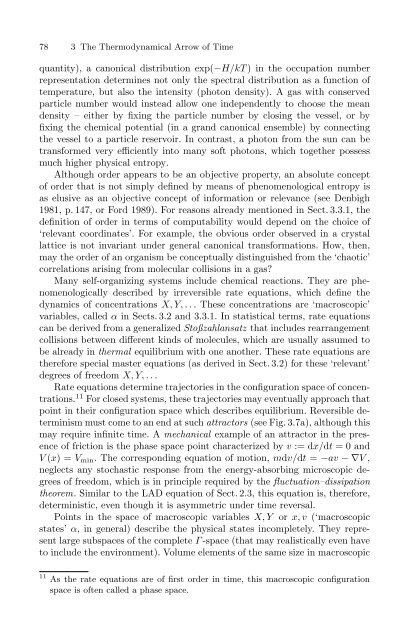The Physical Basis of The Direction of Time (The Frontiers ...
The Physical Basis of The Direction of Time (The Frontiers ...
The Physical Basis of The Direction of Time (The Frontiers ...
You also want an ePaper? Increase the reach of your titles
YUMPU automatically turns print PDFs into web optimized ePapers that Google loves.
78 3 <strong>The</strong> <strong>The</strong>rmodynamical Arrow <strong>of</strong> <strong>Time</strong><br />
quantity), a canonical distribution exp(−H/kT) in the occupation number<br />
representation determines not only the spectral distribution as a function <strong>of</strong><br />
temperature, but also the intensity (photon density). A gas with conserved<br />
particle number would instead allow one independently to choose the mean<br />
density – either by fixing the particle number by closing the vessel, or by<br />
fixing the chemical potential (in a grand canonical ensemble) by connecting<br />
the vessel to a particle reservoir. In contrast, a photon from the sun can be<br />
transformed very efficiently into many s<strong>of</strong>t photons, which together possess<br />
much higher physical entropy.<br />
Although order appears to be an objective property, an absolute concept<br />
<strong>of</strong> order that is not simply defined by means <strong>of</strong> phenomenological entropy is<br />
as elusive as an objective concept <strong>of</strong> information or relevance (see Denbigh<br />
1981, p. 147, or Ford 1989). For reasons already mentioned in Sect. 3.3.1, the<br />
definition <strong>of</strong> order in terms <strong>of</strong> computability would depend on the choice <strong>of</strong><br />
‘relevant coordinates’. For example, the obvious order observed in a crystal<br />
lattice is not invariant under general canonical transformations. How, then,<br />
may the order <strong>of</strong> an organism be conceptually distinguished from the ‘chaotic’<br />
correlations arising from molecular collisions in a gas?<br />
Many self-organizing systems include chemical reactions. <strong>The</strong>y are phenomenologically<br />
described by irreversible rate equations, which define the<br />
dynamics <strong>of</strong> concentrations X,Y,... <strong>The</strong>se concentrations are ‘macroscopic’<br />
variables, called α in Sects. 3.2 and 3.3.1. In statistical terms, rate equations<br />
can be derived from a generalized Stoßzahlansatz that includes rearrangement<br />
collisions between different kinds <strong>of</strong> molecules, which are usually assumed to<br />
be already in thermal equilibrium with one another. <strong>The</strong>se rate equations are<br />
therefore special master equations (as derived in Sect. 3.2) for these ‘relevant’<br />
degrees <strong>of</strong> freedom X,Y,...<br />
Rate equations determine trajectories in the configuration space <strong>of</strong> concentrations.<br />
11 For closed systems, these trajectories may eventually approach that<br />
point in their configuration space which describes equilibrium. Reversible determinism<br />
must come to an end at such attractors (see Fig. 3.7a), although this<br />
may require infinite time. A mechanical example <strong>of</strong> an attractor in the presence<br />
<strong>of</strong> friction is the phase space point characterized by v := dx/dt = 0 and<br />
V (x) =V min . <strong>The</strong> corresponding equation <strong>of</strong> motion, mdv/dt = −av −∇V ,<br />
neglects any stochastic response from the energy-absorbing microscopic degrees<br />
<strong>of</strong> freedom, which is in principle required by the fluctuation–dissipation<br />
theorem. Similar to the LAD equation <strong>of</strong> Sect. 2.3, this equation is, therefore,<br />
deterministic, even though it is asymmetric under time reversal.<br />
Points in the space <strong>of</strong> macroscopic variables X, Y or x, v (‘macroscopic<br />
states’ α, in general) describe the physical states incompletely. <strong>The</strong>y represent<br />
large subspaces <strong>of</strong> the complete Γ -space (that may realistically even have<br />
to include the environment). Volume elements <strong>of</strong> the same size in macroscopic<br />
11 As the rate equations are <strong>of</strong> first order in time, this macroscopic configuration<br />
space is <strong>of</strong>ten called a phase space.



![arXiv:1001.0993v1 [hep-ph] 6 Jan 2010](https://img.yumpu.com/51282177/1/190x245/arxiv10010993v1-hep-ph-6-jan-2010.jpg?quality=85)


![arXiv:1008.3907v2 [astro-ph.CO] 1 Nov 2011](https://img.yumpu.com/48909562/1/190x245/arxiv10083907v2-astro-phco-1-nov-2011.jpg?quality=85)








![arXiv:1002.4928v1 [gr-qc] 26 Feb 2010](https://img.yumpu.com/41209516/1/190x245/arxiv10024928v1-gr-qc-26-feb-2010.jpg?quality=85)
![arXiv:1206.2653v1 [astro-ph.CO] 12 Jun 2012](https://img.yumpu.com/39510078/1/190x245/arxiv12062653v1-astro-phco-12-jun-2012.jpg?quality=85)
